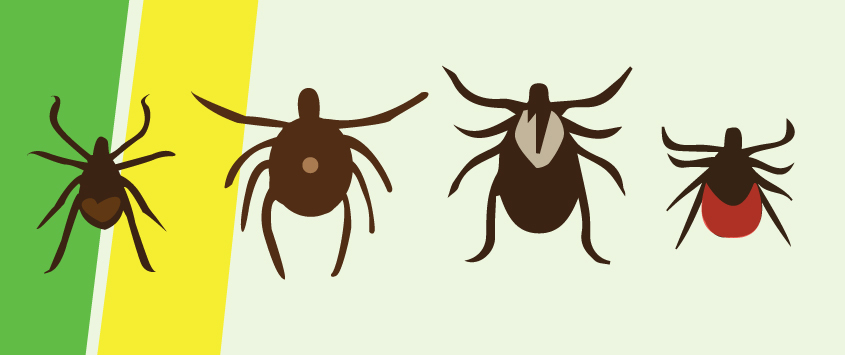
Mosquito Joe explains that not all ticks carry Lyme disease.
|
Did you find an unwanted friend during your post-hike tick check? Don’t panic! Staying calm is essential as you properly remove the tick. Maybe you’ve heard that ticks carry Lyme disease and other dangerous diseases. And, while that’s true, do all ticks carry Lyme disease?
Let’s explore the connections between tick bites and Lyme disease to minimize confusion and clear up common misconceptions.
Types of Ticks and Lyme Disease
Do all ticks carry Lyme disease? No, they don’t.
There are about 850 tick species worldwide, with 90 species active in the United States. Only the infected ticks of two species spread Lyme disease. So, what ticks carry Lyme disease? One is the blacklegged tick, also known as the deer tick (lxodes scapularis). The other is the western blacklegged tick (lxodes pacificus).
While these two species of ticks can carry Lyme disease, it doesn’t mean they all do. They have to be infected, too! Depending on the location, the number of Lyme disease ticks varies from less than 1% to more than 50% of the species.
However, Lyme disease ticks can be dangerous, so stay alert and cautious.
When checking for deer ticks and western blacklegged ticks, remember that they are both small, have flat, oval bodies, and are usually reddish-brown or orange-brown with dark legs — however, their color and size change throughout different points of the tick life cycle. The western blacklegged ticks may have a slightly more oval shape but are mostly identified according to the location where they are found. Their U.S. presence is most dominant in the Pacific Coast states (California, Oregon, and Washington), but they have also appeared in some neighboring western states.
Deer ticks can be found throughout the eastern United States, but Lyme disease is most prevalent in New Jersey, Pennsylvania, Wisconsin, New York, Massachusetts, Connecticut, Minnesota, Maryland, Virginia, New Hampshire, Delaware, and Maine.
As for other species of ticks, it’s important to watch out for them too, because while all ticks do not carry Lyme disease, they can pose other dangers.
These blood-feeding insects thrive throughout the United States and are always searching for a host. And both humans and animals—especially white-tailed deer and chipmunks—make for a tasty meal. Ticks like to live in wooded areas, grassy environments, and, unfortunately, your yard.
How Lyme Disease Is Transmitted
Lyme disease is primarily transmitted through tick bites. When a tick feeds on an infected animal, typically mice or deer, it becomes infected itself. It will transmit the infection by transferring it into the bloodstream by biting its next host.
Transmission typically only occurs if the tick has been attached to its host for 24 to 48 hours. So, if you caught the tick before then, you could be in the clear!
Preventing Tick Bites
The best way to prevent tick bites is to avoid where they live. When you do wander outdoors, cover as much skin as possible. Whenever you return from places like heavily wooded areas or areas with tall grass, do a quick body scan to see if you brought any little critters home with you. Remember, the sooner you spot a tick on you, the better!
But what do you do when ticks start to live where you live? It’s time for a tick control plan! Using traditional pest control methods or eco-friendly options will help rid your space of these and other unwanted visitors.
The threat of ticks can be unsettling, but you don’t have to face it alone. Your local Mosquito Joe® provides exceptional pest control services to help you make going outside fun again.
What To Do if Bitten by a Tick
If you notice a tick on your body, get fine-tipped tweezers to remove it. Grasp the tick as close to your body as possible and pull upward with slow and steady pressure. It’s incredibly important to get the entire tick, including the head and mouth parts, out of your body. If you remove the tick's body without the head, you are still at risk of transmitting bacteria and diseases.
After you’ve removed the tick, clean the bite with rubbing alcohol or soap and warm water. If you want to save the tick for testing purposes, put it in a small bag or container. If not, flush it down the toilet. Never crush a tick, as this also increases the odds of disease transmission.
Lyme disease symptoms can take several weeks to develop, so monitor the bite carefully. If you develop a rash at the bite spot or other symptoms like a fever, chills, body aches, or a headache, consult your healthcare provider.
Mosquito Joe’s Tick Control Services
Call in the pros to protect your property and reduce your risk of contracting Lyme disease from a tick bite. Your local Mosquito Joe experts are ready and waiting to defend your property!
Our Mosquito Joe services are designed to meet your specific needs and rid your property of those disease-carrying biters! The best part is that our services are backed by the Neighborly Done Right Promises® and the Mosquito Joe Satisfaction Guarantee, so you can rest assured you’ll be satisfied with the results.
Get rid of ticks and other insects and enjoy your outside space again. Request a free estimate of our tick control services today!
This article is intended for general informational purposes only and may not be applicable to every situation. You are responsible for determining the proper course of action for your home and property. Mosquito Joe is not responsible for any damages that occur as a result of this blog content or your actions. For the most accurate guidance, contact your local Mosquito Joe location for a comprehensive, on-site assessment.
